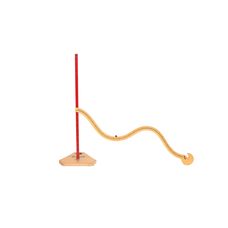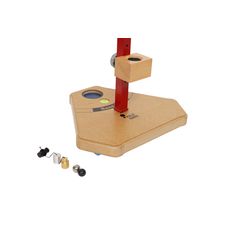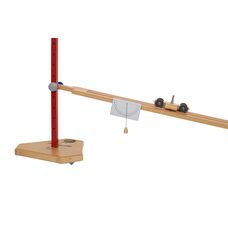Philip Harris Foundation Physics - Universal Stand
Philip Harris Foundation Physics - Universal Stand
Product code: EP00054183
Product Description
The Universal Stand is the central piece of our Foundation Physics range and has been designed to accommodate a range of accessories which facilitate the teaching of many Physics topics. It consists of a solid wooden base with a uniquely stable shape and has levelling feet and a spirit level, which provides improved accuracy for each experiment of the Foundation Physics range. The stand has a number of holes through which to attach the Foundation Physics accessories (available separately).
The Universal Stand comes with:
- Instructions
- Heavy-duty metal pole (with 19 evenly spaced holes)
- Turning Rod
- Bolt
- Washer
- Bull's eye level with adjustable rubber levelling feet
- Versatile multi-functional stand which, when combined with additionally purchased accessories, aids with the teaching of many Physics topics.
- Key Stage 3 Physics - Motion and Forces: Forces being needed to cause objects to stop or start moving, or to change their speed or direction of motion (qualitative only). Forces: associated with deforming objects; stretching and squashing – springs; with rubbing and friction between surfaces, with pushing things out of the way; resistance to motion of air and water. Speed and the quantitative relationship between average speed, distance and time (speed = distance ÷ time). Force-extension linear relation; Hooke’s Law as a special case. Opposing forces and equilibrium: weight held by stretched spring or supported on a compressed surface.
- Key Stage 3 Physics – Energy: Other processes that involve energy transfer: changing motion, dropping an object, completing an electrical circuit, stretching a spring, metabolism of food, burning fuels.
- Key Stage 3 Physics – Waves: Sound needs a medium to travel, the speed of sound in air, in water, in solids. Use of ray model to explain imaging in mirrors, the pinhole camera, the refraction of light and action of convex lens in focusing (qualitative); the human eye. The similarities and differences between light waves and waves in matter.
- Key Stage 4 Physics – Forces: Forces as vectors. Forces and fields: electrostatic, magnetic, gravity.
- Key Stage 4 Physics - Forces and Motion: Speed of sound, estimating speeds and accelerations in everyday contexts. Interpreting quantitatively graphs of distance, time, and speed. Acceleration caused by forces; Newton’s First Law.
- Key Stage 4 Physics – Energy: Conservation of energy in a closed system, dissipation. Energy changes in a system involving heating, doing work using forces, or doing work using an electric current: calculating the stored energies and energy changes involved.
- Key Stage 4 Physics - Wave Motion: Amplitude, wavelength, frequency, relating velocity to frequency and wavelength. Transverse and longitudinal waves
A multitude of topics can be covered using the Universal Stand and its accessories, including:
- Speed, acceleration, motion
- Sound
- Optics
- Energy
- Waves
- Hooke's Law
Further Information
- Age Recommended from
- 11 Years
- Age Recommended to
- 18 Years
- Age Suitability Message
- Warning: This product is not a toyadult supervision is required at all times whilst is use
- Age Suitable from
- 11 Years
- Brand
- Philip Harris
- Product Type
- Universal Stand
- Range
- Foundation Physics
Documents
The Universal Stand is the central piece of our Foundation Physics range and has been designed to accommodate a range of accessories which facilitate the teaching of many Physics topics. It consists of a solid wooden base with a uniquely stable shape and has levelling feet and a spirit level, which provides improved accuracy for each experiment of the Foundation Physics range. The stand has a number of holes through which to attach the Foundation Physics accessories (available separately).
The Universal Stand comes with:
- Instructions
- Heavy-duty metal pole (with 19 evenly spaced holes)
- Turning Rod
- Bolt
- Washer
- Bull's eye level with adjustable rubber levelling feet
- Versatile multi-functional stand which, when combined with additionally purchased accessories, aids with the teaching of many Physics topics.
- Key Stage 3 Physics - Motion and Forces: Forces being needed to cause objects to stop or start moving, or to change their speed or direction of motion (qualitative only). Forces: associated with deforming objects; stretching and squashing – springs; with rubbing and friction between surfaces, with pushing things out of the way; resistance to motion of air and water. Speed and the quantitative relationship between average speed, distance and time (speed = distance ÷ time). Force-extension linear relation; Hooke’s Law as a special case. Opposing forces and equilibrium: weight held by stretched spring or supported on a compressed surface.
- Key Stage 3 Physics – Energy: Other processes that involve energy transfer: changing motion, dropping an object, completing an electrical circuit, stretching a spring, metabolism of food, burning fuels.
- Key Stage 3 Physics – Waves: Sound needs a medium to travel, the speed of sound in air, in water, in solids. Use of ray model to explain imaging in mirrors, the pinhole camera, the refraction of light and action of convex lens in focusing (qualitative); the human eye. The similarities and differences between light waves and waves in matter.
- Key Stage 4 Physics – Forces: Forces as vectors. Forces and fields: electrostatic, magnetic, gravity.
- Key Stage 4 Physics - Forces and Motion: Speed of sound, estimating speeds and accelerations in everyday contexts. Interpreting quantitatively graphs of distance, time, and speed. Acceleration caused by forces; Newton’s First Law.
- Key Stage 4 Physics – Energy: Conservation of energy in a closed system, dissipation. Energy changes in a system involving heating, doing work using forces, or doing work using an electric current: calculating the stored energies and energy changes involved.
- Key Stage 4 Physics - Wave Motion: Amplitude, wavelength, frequency, relating velocity to frequency and wavelength. Transverse and longitudinal waves
A multitude of topics can be covered using the Universal Stand and its accessories, including:
- Speed, acceleration, motion
- Sound
- Optics
- Energy
- Waves
- Hooke's Law
Further Information
- Age Recommended from
- 11 Years
- Age Recommended to
- 18 Years
- Age Suitability Message
- Warning: This product is not a toyadult supervision is required at all times whilst is use
- Age Suitable from
- 11 Years
- Brand
- Philip Harris
- Product Type
- Universal Stand
- Range
- Foundation Physics





